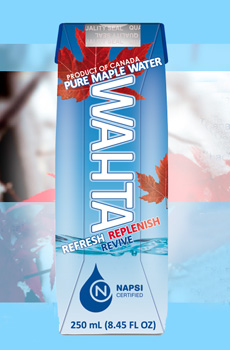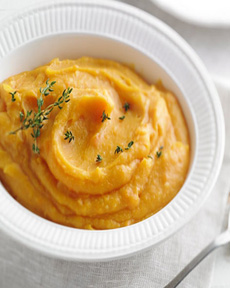PRODUCT: Maple Water
 Be on the lookout for maple water, the newest maple product from Canada. Photo courtesy Wahta. |
Following the galloping success of coconut water, the next “tree water” to hit the market is maple water, made from the sap of the maple tree.
Maple water is actually pure maple sap that is tapped in the spring—a fleeting opportunity that produces a fresh drink that is clear as water, yet full of natural nutrients. In the spring, the tree water has not yet thickened into the sap that will be boiled down for maple syrup later in the year (trivia: it takes 40 gallons of maple sap to make one gallon of maple syrup!). Maple water is a healthy choice for hydration, with 47 essential vitamins and minerals including potassium, manganese and zinc; as well as amino acids, polyphenols (antioxidants) and phytohormones. These properties make it an excellent thirst quencher for athletes and others. Maple water is naturally low in sugar and has only 20 calories per serving size (8.45 ounces/250 ml), compared to an average of 50 calories for the same serving size of coconut water. It is all natural, fat and cholesterol free. |
|
|
Just as coconut water has the delicate flavor of coconut, maple water has the delicate flavor of maple. It has long been consumed by native tribes, but has been recently commercialized ato provide added revenue for maple syrup producers. Maple water has been available for two years in Canada, and is beginning to find its way into the U.S. (and to be produced by maple growers in the U.S.). To ensure authenticity and quality, The Federation of Quebec Maple Syrup Producers has implemented a program called NAPSI certification, for harvesting and bottling. The name is an acronym for: |
||
|
USES FOR MAPLE WATER Maple water can be enjoyed from the carton for thirst-quenching or rehydrating, as a simple drink with ice cubes. It is also becoming popular as an ingredient in recipes. When used in cooking, it gives foods a fine, delicately scented and slightly sweet flavor, and imparts a unique and distinctive character with a subtle hint of sweetness to cocktails, drinks and smoothies. Some suggestions: |
 Carrot purée made with maple water. Here’s the recipe. Photo courtesy ILoveMaple.ca. |
|
|
We received samples of a brand called Wahta Pure Maple Water. Wahta, which coincidentally sounds like “water,” is the word for the sugar maple tree in the language of Canada’s First Nations people, whose longtime use of it as a tonic inspired commercial production. Other Canadian brands include Maple 3, Ovivia and Seva. U.S. brands include Drink Water, Happy Tree and Vertical Water. If maple water takes off like coconut water has, retailers will have to hang additional shelves from the ceiling!
|
||